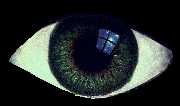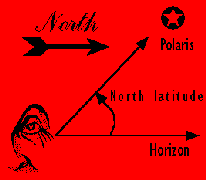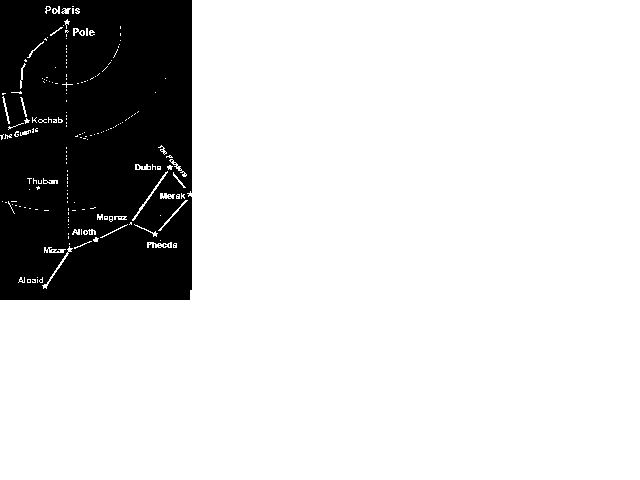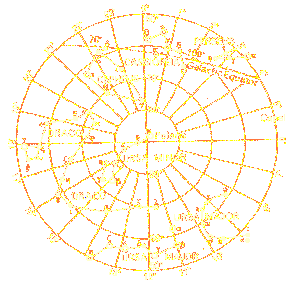

Naked Eye Stargazing, Learning the Sky
Jump to Page Navigation Buttons--![]()
|
What can you see, naked-eye stargazing? Well, not -- as I've shown them here, magnified -- the "7" Pleiades, the "7 sisters" or Lakota Tayamni pa (the Animal's head), also called Wichinkala Shakowin, the 7 little girls. The Pleiades will give us something to focus on, about star ID's and naked-eye stargazing. For starters, virtually everyone who makes computer astronomy software thinks you can see exactly 9600 stars, the database all of them use for "naked eye visibility." How this is defined is that it is all stars down from the brightest, Sirius, (Lakota Tayamni Sinte) whose magnitude is actually negative (the smaller the magnitude, brighter the star, i.e. brightness varies inversely to magnitude) down to magnitude 6.5 which is said to be naked-eye visible. Nobody can really see -- or count and distinguish -- that many in personal naked-eye observing. How are magnitudes established? People see stars differently in comparison, due not only to viewing conditions but to different kinds of eye light sensitivity (some people's eyes respond more to certain color-tints than others). Magnitudes nowadays are measured by light-sentistive instruments, photometers, which is objective but often doesn't agree with how you, in particular, see it, and definitely does not agree with the recorded history of observations. Captain William Henry Smyth's Bedford Catalog of 1850 lists stars as he saw them in England. He says: "The number of stars seen by the naked eye at once is seldom much above a thousand; though from their scintillation and the indistinct manner in which they are viewed, they appear to be almost infinite. Indeed, albeit the keen glances of experience might do more, the whole number that can generally be perceived by the naked eye, taking both hemispheres, is not greatly above three thousand, from the first to the sixth magnitudes." We in the north cannot see "both hemisphres" (which were of great concern to Smyth, as a far-sailing ship's captain). Depending on how far north we are located, we may be unable to see much below the lower part of the zodiac. Then, there is dust. water vapor and pollution in the atmosphere, and what astronomers call "light pollution" from cities. And . . . from the moon! Atmospheric conditions also make a difference, and that's more a matter of water vapor and temperature layers in the atmosphere than of air pollution. The ideal stargazing night is moonless, far from cities, still, and warm, but winter stargazing -- if you dress very warmly -- is quite rewarding too.  Though records of the Pleiades as 7 are extremely ancient (6000 years), there are also a lot of ancient records of them as 6, and old legends about the "missing sister" where she went. Quite a few people (in good viewing conditions) can see 6, most of us can make out the 4 biggies that form a square just about the right size (a little over 31 angular minutes, half a degree) to frame a full moon. Still, the brightest Pleiad is only of magnitude 3. "Only 6 are visible to the average observer, and whoever can see 7 can readily see at least 2 more," so wrote Richard Hinkley Allen, a Yale astronomer in 1899. And, as you magnify, you find more and more in the group. So there are, 5, 6, 7, 9, 14 Pleiades (all naked eye counts given by various observers). In less famous parts of the sky there can be even more confusion, due to differences in seeing.
Just 20 bright stars, 5 of which are never visible in most of the hemisphere where Native North American people live, is not much to memorize. Sky identification and memorization will also mean recognizing the conventional constellations in which they are located. You'll need to watch outside with star charts, because you won't be taught, by scouts (or elders) who well know the night sky. Today there isn't the emphasis on memory training that so-called primitive people, that is, those without writing, almost always have in any part of teaching. But you can "see" from the relatively small number of visual anchors (not all of the 15 are visible each night, it changes by the month) and mnemonic structures (constellation groups) that memorizing the sky even without a great many written or pictorial aids, was very possible and quite likely for a people who livred under that sky and travelled considerable distances over areas with relatively few natural landmarks: plains, prairies, deserts. Navigation by the stars is almost as important for this as for ships. Stars also figured as timekeepers, and for religious-cultural ceremonies and purposes. When stargazing, take a chart or charts, something whose corrections for your location (and time) you understand.. Prepare a flashlight that won't interfere with dark-adapted vision -- one covered with red cellophane or plastic. Blankets, sleeping bags to wrap up in if it gets cold, canvas and to sit on, for summer stargazing. Bring a thermos of coffee and something to eat, even if you don't plan to stay all night and watch till dawn. If this is a winter watch, make sure you have plenty of warm clothing, boots, socks, gloves. One of those beach folding chairs that folds down to a cot, so you can sit up or lie on your back and look up is better than lying on the ground, even if sheltered and swept clean of snow. Go away from any cars or vans. Don't bring a radio. If you have a fire, make it over the hill and well out of sight of your skyview place. Binocs? You can try them, but until you learn the sky, and a locator technique called star-hopping, you aren't going to know what you're seeing through them, and it's hard to hold them steady enough for starfields. Learn the sky first, before magnifying it. Sketchpad and fine fiber-tipped pen (easy to write with, shows up well in dim red light) are nice to have along.
For stargazers, the two end-stars of the dipper's bowl -- Dubhe, mag. 2, the inner rim or pouring lip, and Merak (mag. 2.5), bottom-of-the-bowl are the most important of the northern stars. These are "the pointers" which point to Polaris (mag 2.2), no matter how the stars revolve through the night. Polaris -- now -- is very nearly the northern sky-pole (11 minutes of arc from the true empty pole-hole) pierced by the earth's axis of revolution, so that the celestlal globe appears to revolve about it. Big Dipper has one very faint 8th star that's a test of eyesight. Mizar, one in from the handle's end, has a faint companion, Alcor 11'48" away. Desert tribal Arabs used ability to resolve Alcor, "the rider" from Mizar, "the horse" as a test of eyesight.
So printed magazine star charts give the hour at which the sky will look as shown. This hour marches along, getting later, through the night as the month progresses. Monthly starwatch magazines generally publish a chart valid for "first full dark" whenever that is by season, and give a set of times -- later and later until nearly dawn -- throughout the month that the sky will have this appearance. So you really need to bring several months' star charts on your night-long skywatch, the night toward the end of the month may start with stars in a configuration from several months before. The night toward the beginning may start with the stars as shown in "this month's chart" but will progress with stars sinking and rising to several successive months -- although not exactly, because in earlier and later months, the plane of the ecliptic (hence the zodiac) is going to be in different north-south positions. What all of this adds up to is that star dial finders, where you buy a dial with the sky as it will appear through all seasons at your approximate latitude and turn the cardboard or plastic rim-wheel for date and time are the most useful aids to night-watching novices. Several dial-finders are listed below, here, from catalog sources.
Use the northern cap of circumpolar stars to orient yourself to printed sky charts, as well as the night skies. These stars will revolve around the pole all night, and be like a big clock-face. When you look at a printed star chart (or dialfinder), you'll iusually see a printed sky-circle. Polaris will be to the north (top) of it. Unlike printed maps, East is at the left and West is to the right of the printed chart. Hold the page over your head, facing north and pointing the top of the page north. As you see, that way, the chart's east-west orientation is correct, but it's hard to get used to, because we've learned the "East = right side, west = left side" paper map convention so well it is second nature. Anyway, you'll see the pole and circumpolar stars to the north, topside, of the printed star chart. The circumpolar star positions relate to time of night; the others, below it, to what will be visible at the appropriate "circumpolar star time" on a particular date. Magazine star charts are usually prepared to be valid for about a month, later and later in the evening. Bon the Stars menu, here, you'll find at the top a link-to Astronomy magazine's monthly sky events page. From there, you can explore other parts of the magazine, and some of its back issues. |
|---|
 One observational instrument you'll always have with you -- your hands. Stand and hold one hand at arm's length, make a fist and raise your thumb. Your thumb measures roughly 5 degrees of arc against the stars, your thumbnail (not its long extension, if you're female with long nails!) measures about 1 degree. With arm fully extended, the base of your clenched fist or its length from wrist to forefinger knuckle measures about 10 degrees of arc. And the length from the bottom of the palm at wrist through upraised thumb (fist plus thumb) is about 15 degrees of arc, the amount of revolution the earth does in an hour -- for stars not close to the pole that are rising and setting through the sky's zenith.
One observational instrument you'll always have with you -- your hands. Stand and hold one hand at arm's length, make a fist and raise your thumb. Your thumb measures roughly 5 degrees of arc against the stars, your thumbnail (not its long extension, if you're female with long nails!) measures about 1 degree. With arm fully extended, the base of your clenched fist or its length from wrist to forefinger knuckle measures about 10 degrees of arc. And the length from the bottom of the palm at wrist through upraised thumb (fist plus thumb) is about 15 degrees of arc, the amount of revolution the earth does in an hour -- for stars not close to the pole that are rising and setting through the sky's zenith. Spring, summer, fall or winter the circumpolar stars of the north are visible; that's always the best place to begin learning the night sky. Let's look north at Polaris (Lakota Wichapi Owangila, star that stands in one place). This is the most useful direction for peoples in the northern hemisphere to look at the skies. If you take a sight on the elevation of Polaris above a flat horizon, the angle of elevation is your latitude -- how far north you are in angular degrees. This changes only over the 26,000 year precessional cycle which can be ignored. While all mariners know, or once knew, this, there can be no question that native peoples of the plains, prairies, and deserts did too. It would be of enormous use in "navigating" on open, relatively landmark-less plains. But as lake-and-woods area hikers know, if you can get clear sighting, it can orient you at night, too. Mountains, too, have a tendency to look pretty much alike in high, rocky places you visit infrequently. There's never been any question in my mind that pre-television peoples of the plains, deserts, prairies would know the night skies.
Spring, summer, fall or winter the circumpolar stars of the north are visible; that's always the best place to begin learning the night sky. Let's look north at Polaris (Lakota Wichapi Owangila, star that stands in one place). This is the most useful direction for peoples in the northern hemisphere to look at the skies. If you take a sight on the elevation of Polaris above a flat horizon, the angle of elevation is your latitude -- how far north you are in angular degrees. This changes only over the 26,000 year precessional cycle which can be ignored. While all mariners know, or once knew, this, there can be no question that native peoples of the plains, prairies, and deserts did too. It would be of enormous use in "navigating" on open, relatively landmark-less plains. But as lake-and-woods area hikers know, if you can get clear sighting, it can orient you at night, too. Mountains, too, have a tendency to look pretty much alike in high, rocky places you visit infrequently. There's never been any question in my mind that pre-television peoples of the plains, deserts, prairies would know the night skies.
 The bigger pic above shows by arrows the direction of apparent rotation of the sky around Polaris (star chart convention not used, East is the right.) My picture at the left here shows a time-lapse photo taken over about an hour, with the camera fixed on Polaris -- actually at the sky's true north pole, a little bit away. You can see a skeletal tree in the lower left corner and a bright blur caused by a crescent moon, which is going its own way, among the "fixed stars". Each star trail is really (or should have been captured as) a streak forming an arc of 15°, the amount of earth's rotation in about an hour. The two dippers or bears form a big night clock, as they rotate around the pole, for the changing appearance of the night sky as it appears to revolve during the darkness of a skywatch period, Those changes are comparatively rapid. Stars below the 60-degree sky circle that marks the never-setting circumpolar stars rise and set. For this reason, star charts, which are always seasonal (because of the big changes in what's visible due to the earth's tilted axis, and the
The bigger pic above shows by arrows the direction of apparent rotation of the sky around Polaris (star chart convention not used, East is the right.) My picture at the left here shows a time-lapse photo taken over about an hour, with the camera fixed on Polaris -- actually at the sky's true north pole, a little bit away. You can see a skeletal tree in the lower left corner and a bright blur caused by a crescent moon, which is going its own way, among the "fixed stars". Each star trail is really (or should have been captured as) a streak forming an arc of 15°, the amount of earth's rotation in about an hour. The two dippers or bears form a big night clock, as they rotate around the pole, for the changing appearance of the night sky as it appears to revolve during the darkness of a skywatch period, Those changes are comparatively rapid. Stars below the 60-degree sky circle that marks the never-setting circumpolar stars rise and set. For this reason, star charts, which are always seasonal (because of the big changes in what's visible due to the earth's tilted axis, and the 
 Here are the northern stars -- a cap whose center is Polaris and showing all the conventional constellations above 60 degrees. These revolve around Polaris all night (and invisibly, all day), they never rise or set for observers in the northern hemisphere. Brilliant Capella -- the northernmost marker on the Lakota sacred circle of stars that forms the racetrack -- is indicated just outside the northern circle a few minutes before 3 o'clock. It's located just below the 60 degree sky-latitude circle. For most of us, it never rises or sets. It may skim the horizon. For most of us such as me in a city, our horizons aren't a distant flat. Capella is often behind buildings or trees from my apartment balcony.
Here are the northern stars -- a cap whose center is Polaris and showing all the conventional constellations above 60 degrees. These revolve around Polaris all night (and invisibly, all day), they never rise or set for observers in the northern hemisphere. Brilliant Capella -- the northernmost marker on the Lakota sacred circle of stars that forms the racetrack -- is indicated just outside the northern circle a few minutes before 3 o'clock. It's located just below the 60 degree sky-latitude circle. For most of us, it never rises or sets. It may skim the horizon. For most of us such as me in a city, our horizons aren't a distant flat. Capella is often behind buildings or trees from my apartment balcony.